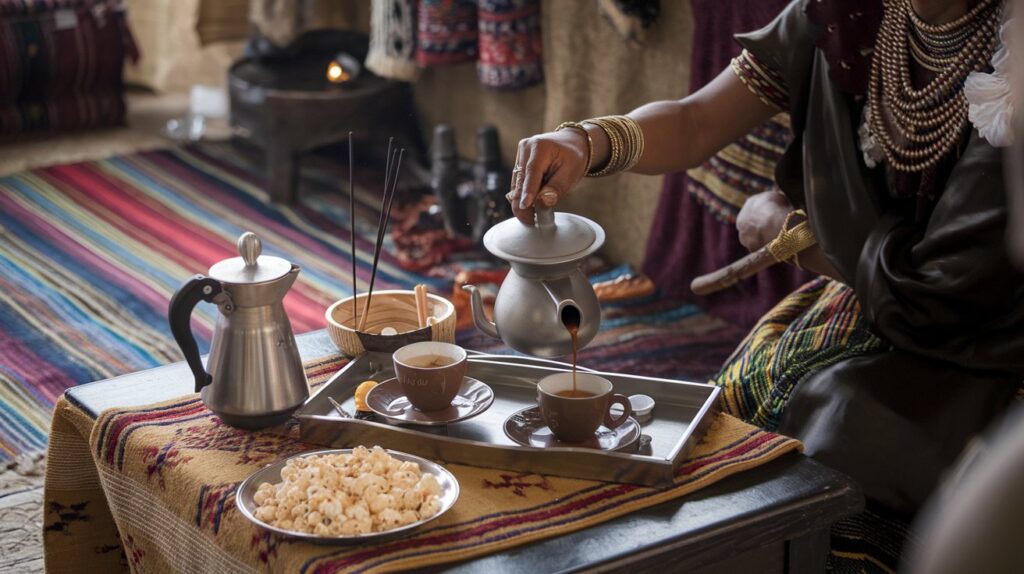The Ethiopian Coffee Ceremony: A Ritual of Community
*We may earn a commission for purchases made using our links. Please see our disclosure to learn more.
As I stepped into my Ethiopian friend’s home for the first time, the rich aroma of freshly roasted coffee beans immediately transported me to a world of ancient traditions and cherished customs. The Ethiopian coffee ceremony, known locally as “Jebena Buna,” isn’t just about drinking coffee. It’s a deeply spiritual and social ritual that has been passed down through generations, serving as a testament to Ethiopia’s profound connection to coffee’s origins. Over the years, I’ve had the privilege of participating in numerous ceremonies. Each one teaching me something new about this remarkable tradition that has captivated coffee lovers and cultural enthusiasts worldwide.
Key Takeaways
- The Ethiopian coffee ceremony is a ritualistic process that typically takes 2-3 hours
- The ceremony involves three distinct brewing rounds: Abol, Tona, and Baraka
- Fresh coffee beans are roasted, ground, and brewed in front of guests using traditional tools
- The ceremony emphasizes community, hospitality, and mindful connection
- Essential elements include the jebena (clay pot), traditional snacks, and burning incense
The Sacred Origins
Ethiopia is widely recognized as the birthplace of coffee, with the legend of Kaldi the goatherd discovering the energizing effects of coffee berries in the 9th century. The story goes that Kaldi noticed his goats becoming unusually energetic after eating berries from a particular tree. After trying the berries himself and experiencing their invigorating effects, he brought them to a local monastery. The monks initially disapproved and threw the beans into a fire, but the enticing aroma of the roasting beans led them to retrieve them, grind them up, and add them to hot water, creating the world’s first cup of coffee.
But what many don’t know is how deeply intertwined coffee became with Ethiopian culture, spirituality, and daily life. The coffee ceremony evolved as a way to honor this precious bean while strengthening community bonds. As coffee cultivation spread throughout Ethiopia’s highlands, different regions developed their own unique varieties and processing methods, each contributing to the rich tapestry of Ethiopian coffee culture.
Walking into any Ethiopian household today, you’ll find that the coffee ceremony remains a cornerstone of social life. It’s performed for family gatherings, to welcome guests, or simply to mark the passing of each day. As my Ethiopian hosts have taught me, this isn’t just about the coffee, it’s about taking time to be present with one another, sharing stories, and maintaining connections that span generations.
The Ceremonial Space
The preparation of the ceremonial space is an art form in itself. Fresh grass or flowers, typically long strands of fragrant greenery, are scattered on the floor in a tradition known as “spreading of the grass.” This practice creates a symbolic connection to nature and coffee’s origins in the Ethiopian highlands. I’ve learned that each element of the ceremonial space carries deep meaning, the grass represents the abundance of nature, while the arrangement of seats ensures everyone can participate equally in the communal experience.
The burning of frankincense or other traditional incense, known as “etan,” is another crucial element. The smoke rises in delicate tendrils, purifying the air and creating an atmosphere of reverence. Many hosts use a traditional incense burner called a “machesha,” often made of clay or ceramic, which releases the fragrant smoke throughout the ceremony. The combination of coffee and incense creates a multisensory experience that helps participants transition from their daily concerns to a more contemplative state.
The Role of the Host
The host, traditionally a young woman, takes on a role that’s part artist, part spiritual guide, and part social facilitator. She typically wears a traditional white cotton dress called a “habesha kemis,” adorned with colorful woven borders that showcase Ethiopia’s rich textile traditions. The dress itself is a symbol of purity and respect for the ceremony.
The host’s responsibilities extend far beyond just making coffee. She must carefully arrange the ceremonial tools, maintain the proper pace of the ceremony, and ensure that all guests feel welcomed and included. The tools of her trade are themselves works of art:
- The jebena: A handcrafted clay coffee pot with a distinctive round base, long neck, and straw lid
- The sinni: A clay tray that holds the cups and catches any spills
- The mukecha and zenezena: The wooden mortar and pestle used for grinding
- The mishrafat: A pan for roasting the beans
- Small ceramic cups called “cini” or “finjal”
The Roasting Ritual
The first step in the ceremony is roasting the green coffee beans, a process that transforms both the beans and the atmosphere of the gathering. The host begins by washing the beans to remove any debris, then carefully placing them in the mishrafat. Over a hot coal brazier or modern stove, she continuously moves the beans to ensure even roasting while guests gather around, engaging in conversation.
This part of the ceremony engages all the senses. The beans change color from green to yellow to various shades of brown, releasing oils that give them a glossy sheen. The crackling sounds of the beans mark their progression through different roasting stages. But perhaps most importantly, the aroma evolves from grassy to bread-like to the complex bouquet of fully roasted coffee.
When the beans reach their perfect roast, typically darker than many Western roasts. The host moves through the room, wafting the smoke toward guests with a graceful fanning motion. This gesture, which I’ve experienced many times, is both practical and symbolic. It allows guests to appreciate the aroma while participating in the transformation of the beans. Many hosts will pause before each guest. Allowing them to wave the smoke toward themselves in a gesture called “berneta.”
The Art of Grinding and Brewing
After the beans cool slightly, the grinding begins. Using the mukecha and zenezena, the host transforms the roasted beans into a coarse powder. The rhythmic sound of grinding becomes a kind of percussion, adding to the ceremony’s sensory experience. Some hosts have specific grinding patterns or rhythms they follow, passed down through their families.
The ground coffee is then carefully added to the water already heating in the jebena. The timing here is crucial, too hot, and the coffee becomes bitter; too cool, and the flavors don’t fully develop. The jebena’s unique shape helps create the perfect brew, with its long neck trapping steam and its round bottom allowing grounds to settle naturally.
The Three Sacred Rounds
The Ethiopian coffee ceremony is a revered cultural practice with three distinct rounds, each carrying unique significance:
Abol (First)
The strongest and most respected cup, Abol sets the tone for the ceremony. Poured from a height to create a foam called “arbol,” it is cherished for its strength and the respect it conveys. The aroma and rich flavor create an atmosphere of reverence.
Tona (Second)
Slightly milder, Tona is appreciated for its subtler flavors. Guests become more relaxed during this round, often engaging in deeper conversations. It represents a shift from formality to a more open, reflective interaction.
Baraka (Third)
The final round, meaning “to be blessed,” is the weakest but holds spiritual importance. Completing all three rounds is believed to bring transformation and blessings. It marks the end of the ceremony and symbolizes the sharing of life’s blessings and strengthened communal bonds.
Each round is accompanied by traditional snacks that enhance the experience and cultural atmosphere:

- Freshly Popped Popcorn: A light, crunchy snack that contrasts with the smooth coffee.
- Roasted Barley or Wheat: Simple grains that reflect the humble nature of the gathering.
- Himbasha: A sweet, spongy bread balancing the coffee’s bitterness, symbolizing warmth and hospitality.
- Kolo: A mixture of roasted barley, peanuts, and sunflower seeds, offering a savory bite that complements the coffee’s rich flavors.
The Ethiopian coffee ceremony is more than a ritual, it’s a celebration of respect, community, and spiritual connection.
Social and Cultural Significance
The Ethiopian coffee ceremony is far more than a simple act of drinking coffee. It holds significant social, cultural, and even spiritual importance within Ethiopian society. Its meaning extends far beyond just the preparation and consumption of coffee:
- A Social Hub: The coffee ceremony serves as a central meeting point where people gather to socialize, exchange news, and build relationships. It is often where community members reconnect, discuss important matters, and bond over the shared experience of the ceremony.
- A Conflict Resolution Forum: The ceremony’s peaceful and reflective atmosphere often creates the perfect setting for resolving conflicts. It provides an opportunity for open dialogue in an environment that encourages patience and understanding, helping to mend relationships and resolve disagreements.
- A Welcome Ritual: Offering coffee to guests is an essential aspect of Ethiopian hospitality. When someone visits a home, they are often welcomed with the invitation to sit and partake in the ceremony. This ritual is not only a gesture of politeness but also an expression of respect and affection for the guest.
- A Business Setting: The Ethiopian coffee ceremony plays a role in the business world as well. Important business discussions and negotiations may take place over coffee, with the ceremony setting the stage for cooperation, mutual respect, and understanding.
- A Family Bonding Time: Families often gather together to perform the coffee ceremony, strengthening their bonds and maintaining cultural traditions. It serves as a time to reflect on family values, share stories, and pass down customs from one generation to the next.
Modern Adaptations and Global Influence
While the traditional Ethiopian coffee ceremony remains deeply ingrained in daily life, modern life has led to some adaptations, especially in urban areas. In fast-paced cities, Ethiopian families may perform abbreviated versions of the ceremony on weekdays, especially when time is limited. However, the full ceremony, with its three rounds and accompanying rituals, is still preserved for weekends and special occasions, maintaining the essence of the cultural experience.
Technology and modernization have also found their way into the coffee ceremony. Electric grinders, modern stoves, and pre-roasted beans are sometimes used to streamline the process, but these adaptations do not take away from the ceremony’s significance. The focus on community, connection, and shared experience remains at the heart of the ritual.
The Ethiopian coffee ceremony’s influence has spread beyond Ethiopia’s borders, with many Ethiopian restaurants around the world offering their own versions of the ceremony. In some cafes and coffee shops globally, elements of the ritual are incorporated into the service, with an emphasis on freshly ground, high-quality coffee beans. This has helped bring greater awareness to Ethiopian coffee culture and its deep cultural significance.
Preserving Tradition in a Modern World
As Ethiopia embraces modernity, the rich tradition of the coffee ceremony continues to thrive. Despite the inevitable changes that come with time, the essence of the ceremony, community, respect, and spiritual connection, remains intact. As more people around the world become familiar with this sacred ritual, the Ethiopian coffee ceremony remains a symbol of resilience, cultural pride, and the importance of shared experiences in an increasingly fast-paced and disconnected world. The ceremony’s ability to adapt while preserving its core values ensures that it will continue to play an essential role in both Ethiopian society and in global appreciation of coffee culture.
Conclusion
The Ethiopian coffee ceremony represents far more than a method of preparing and serving coffee. It’s a living tradition that reminds us of the importance of slowing down, connecting with others, and honoring ancient customs in our modern world. Through my experiences participating in these ceremonies, I’ve gained a deeper appreciation for how ritual and community can enrich our daily lives and preserve cultural heritage. As coffee continues to fuel our modern world, the Ethiopian coffee ceremony stands as a testament to its sacred origins and enduring power to bring people together.
Frequently Asked Questions
Q: How long does a traditional Ethiopian coffee ceremony take?
A: A full traditional ceremony typically takes 2-3 hours, including all three rounds of coffee and social interaction. However, modern adaptations might be shorter while maintaining the essential elements.
Q: What should guests bring to a coffee ceremony?
A: While gifts aren’t required, small offerings like traditional snacks or incense are appreciated. More importantly, guests should bring their time and willingness to participate fully in the experience.
Q: Is it considered rude to leave before all three rounds are served?
A: Yes, traditionally, leaving before the ceremony completes is considered impolite. People regard the third round (Baraka) as blessed, and participating in all rounds shows respect for the host and the tradition.
Q: Can men perform the coffee ceremony?
A: While traditionally performed by women, there’s no strict rule against men conducting the ceremony. In modern times, some men do perform the ceremony, especially in commercial settings or at cultural demonstrations.
Q: What’s the significance of the incense burned during the ceremony?
A: The incense has multiple purposes: it cleanses the ceremonial space, creates a pleasant atmosphere, and is believed to ward off evil spirits. It also adds to the full sensory experience that makes the ceremony special.




